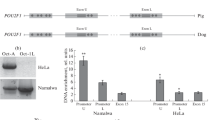Abstract
Transcription factor Oct-1 is involved in expression regulation of housekeeping genes, in lymphocyte differentiation, and in the immune response. Tissue-specific oct-1 mRNA isoforms are known to be expressed in lymphoid cells. Four new mouse isoforms were identified. Of these, two were tissue-specific (oct-1Rα and oct-1Rβ) and contained exon 1L. The oct-1Rα was shown to contain an additional fragment, which corresponds to an exon located in the 3"-region of mouse otf-1. No homolog was found in human OTF-1. The oct-1Rβ isoform proved to lack an exon coding for a fragment of the POU domain. This deletion results in a loss of the first helix of the domain, and the mutant protein is devoid of affinity for octamer ATGCAAAT. Two other mRNA isoforms, oct-1d and oct-1e, were shown to contain untranslated regions between exons 1U and 2. The regions correspond to exons 1i and 2i located between exons 1U and 1L in the 5"-region of the mouse oct-1 gene. Human OTF-1 was not found to contain exon 1i. On evidence of these and published data, it was assumed that a set of oct-1 isoforms is present in the cell, reflecting the complexity of expression regulation of оct-l and the multiplicity of its functions.
Similar content being viewed by others
REFERENCES
Herr W., Sturm R.A., Clerc R.G., Corcoran L.M., Baltimore D., Sharp P.A., Ingraham H.A., Rosenfeld M.G., Finney M., Ruvkun G., Horvitz H.R. 1988. The POU domain: a large conserved region in the mammalian Pit-1, Oct-1, Oct-2, and Caenorhabditis elegans Unc-86 gene products. Genes Dev. 2, 1513–1516.
Fletcher C., Heintz N., Roeder R.G. 1987. Purification and characterization of OTF-1, a transcription factor regulating cell cycle expression of a human histone H2b gene. Cell. 51, 773–781.
Ryan A.K., Rosenfeld M.G. 1997. POU domain family values: flexibility, partnerships, and developmental codes. Genes Dev. 11, 1207–1225.
Pfeuffer I., Klein-Habling S., Heinfling A., Chuvpilo S., Esher C., Brabletz T., Hentch B., Schwarzenbach H., Matthias P., Serfling E. 1994. Octamer factors exert a dual effect on the IL-2 and IL-4 promoters. J. Immunol. 153, 5572–5585.
Wu C.D., Lai E.J., Huang N., Wen X. 1997. Oct-1 and CCAAT/enhancer-binding protein (C/EBP) bind to overlapping elements within the interleukin-8 promoter. The role of Oct-1 as a transcriptional repressor. J. Biol. Chem. 24, 2396–2403.
Kaushansky K., Shoemaker S.G., O'Rork C.A., McCarty J.M. 1994. Coordinate regulation of multiple human lymphokine genes by Oct-1 and potentially novel 45 and 43 kDa polypeptides. J. Immunol. 152, 1812–1820.
Zhao H., Jin S., Fan F., Fan W., Tong T., Zhan Q. 2000. Activation of the transcription factor Oct-1 in response to DNA damage. Cancer Res. 60, 6276–6280.
Jin S., Fan F., Fan W., Zhao H., Tong T., Blanck P., Alomo I., Rajasekaran B., Zhan Q. 2001. Transcription factors Oct-1 and NF-YA regulate the p53-independent induction of the GADD45 following DNA damage. Oncogene. 20, 2683–2690.
Kim M.K., Lesoon-Wood L.A., Weintraub B.D., Chung J.H. 1996. A soluble transcription factor, Oct-1, is also found in the insoluble nuclear matrix and possesses silencing activity in its alaninerich domain. Mol. Cell. Biol. 16, 4366–4377.
Strom A.C., Forsberg M., Lillhager P., Westin G. 1996. The transcription factors Sp1 and Oct-1 interact physically to regulate human U2 snRNA gene expression. Nucleic Acids Res. 24, 1981–1986.
O'Connor M., Bernard H.U. 1995. Oct-1 activates the epithelial-specific enhancer of human papillomavirus type 16 via a synergistic interaction with NFI at a conserved composite regulatory element. Virology. 207, 77–78.
Bruggemeier U., Kalff M., Franke S., Scheidereit C., Beato M. 1991. Ubiquitous transcription factor OTF-1 mediates induction of the MMTV promoter through synergistic interaction with hormone receptors. Cell. 64, 565–572.
Subramaniam N., Cairns W., Okret S. 1998. Glucocorticoids repress transcription from a negative glucocorticoid response element recognized by two homeodomain-containing proteins, Pbx and Oct-1. J. Biol. Chem. 273, 23567–23574.
Luo Y., Fujii H., Gerster T., Roeder R.G. 1992. A novel B cell-derived coactivator potentiates the activation of immunoglobulin promoters by octamer-binding transcription factors. Cell. 71, 231–241.
Pankratova E.V., Deyev I.E., Zhenilo S.V., Polanovsky O.L. 2001. Tissue-specific isoforms of the ubiquitous transcription factor Oct-1. Mol. Genet. Genomics. 266, 239–245.
O'Hare P., Goding C.R. 1988. Herpes simplex virus regulatory elements and the immunoglobulin octamer domain bind a common factor and are both targets for virion transactivation. Cell. 52, 435–445.
Cepek K., Chasman D., Sharp P. 1996. Sequence-specific DNA binding of the B-cell-specific coactivator OCA-B. Genes Dev. 10, 2079–2088.
Chomczynski P., Sacchi N. 1987. Single-step method of RNA isolation by acid guanidinium thiocyanate-phenol-chloroform extraction. Analyt. Biochem. 162, 156–159.
Ceol M., Forino M., Gambaro G., Sauer U., Schleicher E., D'Angelo A., Anglani F. 2001. Quantitation of TGF-beta1 mRNA in porcine mesangial cells by comparative kinetic RT/PCR: comparison with ribonuclease protection assay and in situ hybridization. J. Clin. Lab. Anal. 15, 215–222.
Stepchenko A.G. 1992. The nucleotide sequence of mouse OCT-1 cDNA. Nucleic Acids Res. 20, 1419.
Suzuki N., Peter W., Ciesiolka T., Gruss P., Schoeler H. 1993. Mouse Oct-1 contains a composite home-odomain of human Oct-1 and Oct-2. Nucleic Acids Res. 21, 245–252.
Das G., Herr W. 1993. Enhanced activation of the human histone H2B promoter by an Oct-1 variant generated by alternative splicing. J. Biol. Chetm. 268, 25026–25032.
International Human Genome Sequencing Consortium 2001. Initial sequencing and analysis of the human genome. Nature. 409, 860–921.
Klemm J.D., Rould M.A., Aurora R., Herr W., Pabo C.O. 1994. Crystal structure of the Oct-1 POU domain bound to an octamer site: DNA recognition with tethered DNA-binding modules. Cell. 77, 21–32.
Sturm R.A., Herr W. 1988. The POU domain is a bipartite DNA-binding structure. Nature. 336, 601–604.
Rubtsov P.M. 2000. Alternative promoters and RNA processing in expression of the eukaryotic genome. Mol. Biol. 34, 626–634.
Author information
Authors and Affiliations
Rights and permissions
About this article
Cite this article
Deyev, I.E., Zhenilo, S.V. & Polanovsky, O.L. Spliced oct-1 mRNA Isoforms with Untranslated Exons and a Partly Deleted Region Coding for the POU-Specific Domain. Molecular Biology 37, 125–131 (2003). https://doi.org/10.1023/A:1022349216836
Issue Date:
DOI: https://doi.org/10.1023/A:1022349216836




